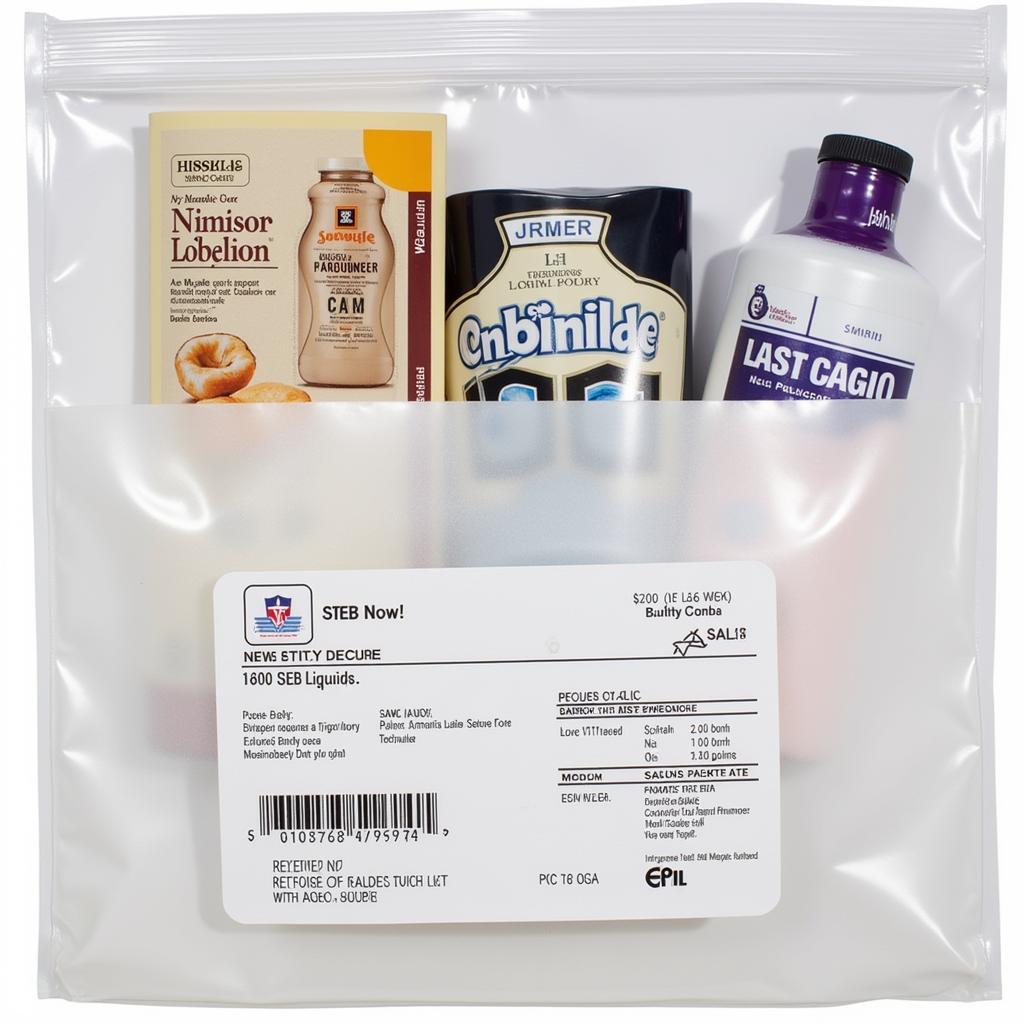Airport Liquid Limits are essential for maintaining safe and secure air travel. These regulations dictate the types and quantities of liquids passengers can bring in their carry-on baggage. Understanding these rules can save you time and frustration at the security checkpoint.
Why Do Airport Liquid Limits Exist?
The primary reason for airport liquid limits is to prevent the carriage of potentially dangerous substances that could be disguised as harmless liquids. This measure enhances security for all passengers and crew. These restrictions were implemented globally after a 2006 terrorist plot in the UK highlighted the potential threat of liquid explosives. Prior to this, passengers were generally allowed to carry larger quantities of liquids in their carry-on bags.
What are the General Airport Liquid Limits?
Most airports worldwide adhere to the 3-1-1 rule for liquids in carry-on baggage. This means liquids, gels, aerosols, creams, and pastes must be in containers no larger than 3.4 ounces (100 milliliters), and all containers must fit in a single, quart-sized, clear, zip-top plastic bag. This bag must be removed from your carry-on and placed in a separate bin for X-ray screening. Remember, it’s the container size that matters, not the amount of liquid inside. Even if your container is larger than 3.4 ounces but only partially filled, it will likely be confiscated.
Are There Any Exceptions to the Airport Liquid Limits?
Yes, there are a few exceptions to the standard airport liquid limits. Medications and baby formula/food are allowed in reasonable quantities exceeding 3.4 ounces, but you must declare them to security officers for separate screening. Duty-free liquids purchased after the security checkpoint are also permitted, provided they are sealed in a secure, tamper-evident bag (STEB). However, be mindful of connecting flights, as these liquids may be subject to restrictions at your transit airport. Similar to regulations on [hand bag for airport], the rules surrounding liquids are designed to ensure the safety of all passengers.
What Happens if I Exceed the Airport Liquid Limits?
If you exceed the airport liquid limits, security officers will likely confiscate the prohibited items. This can be frustrating and inconvenient, especially if you have expensive or essential items. To avoid this situation, carefully review the regulations before packing your carry-on bag. You can also purchase travel-sized containers and transfer larger quantities of liquids into checked baggage. Just remember that even in checked baggage, some hazardous materials are not permitted.
 Airport Security Checkpoint Liquid Confiscation
Airport Security Checkpoint Liquid Confiscation
Tips for Navigating Airport Liquid Limits
- Pack all your liquids in a designated quart-sized bag before arriving at the airport. This will streamline the screening process and reduce your stress. You might even find deals similar to those at [malaysia airport duty free] after security.
- Be prepared to declare medications and baby formula/food to security officers.
- Consider purchasing travel-sized toiletries to avoid exceeding the limits.
- Place larger quantities of liquids in your checked baggage.
- Familiarize yourself with the specific liquid restrictions of your destination and transit airports. You can also check out resources such as [airport procedures for domestic flights in india] for specific country regulations.
What about Duty-Free Liquids?
Duty-free liquids purchased after security are generally allowed on board, even if they exceed the 3-1-1 rule. However, these items must be sealed in a STEB and accompanied by proof of purchase. Be aware that if you have a connecting flight, you may need to re-screen your duty-free liquids at your transit airport, especially if transferring to a domestic flight. Just like knowing the [igi airport duty free shop liquor prices], understanding duty-free regulations can help you save money and avoid surprises.
 Duty-Free Liquids in STEB Bag
Duty-Free Liquids in STEB Bag
Conclusion
Understanding airport liquid limits is crucial for a smooth and stress-free travel experience. By adhering to the 3-1-1 rule and being aware of the exceptions, you can avoid delays and ensure your liquids reach your destination without issue. For those travelling through London, information regarding [heathrow airport terminal 5 duty free shops] can be particularly useful.
FAQ
-
What is the 3-1-1 rule for liquids?
Liquids, gels, and aerosols must be in 3.4-ounce (100ml) containers, placed in a single, quart-sized, clear, zip-top bag. -
Can I bring baby food on the plane?
Yes, baby food and formula are allowed in reasonable quantities exceeding 3.4 ounces. -
What about prescription medications?
Prescription medications are allowed in reasonable quantities exceeding 3.4 ounces. -
Can I buy liquids at the airport after security?
Yes, duty-free liquids purchased after security are allowed. -
What happens if I exceed the liquid limits?
Prohibited liquids may be confiscated by security officers. -
Can I bring water on a plane?
Not through security, but you can purchase water after security or bring an empty bottle to fill up. -
Are there any restrictions on liquids in checked baggage?
Certain hazardous materials are not allowed, even in checked baggage.
For further assistance, please contact us at Phone Number: +13089626264, Email: [email protected] Or visit us at: 404 Bothwell St, Oxford, NE 68967, USA. We have a 24/7 customer service team.
